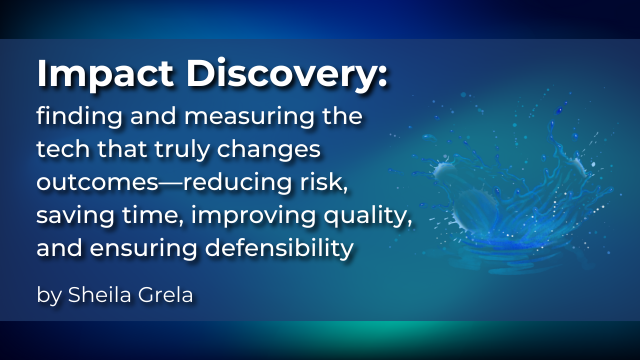
[EDRM Editor’s Note: The opinions and positions are those of Sheila Grela. All images in the article are courtesy of Sheila Grela.]
In legal tech and eDiscovery, “impact discovery” is more than a buzzword. To me, it means asking: Which tools and processes actually change outcomes? Not what’s shiny or fast, but what reduces risk, saves time, improves quality, and stands up in court.
Tech That’s Moving the Needle
So what’s actually moving the needle today? Let’s look at the areas where innovation is doing more than just promising change—it’s delivering measurable results.
Generative AI for Summarization and Logs
First up: generative AI. We’re seeing tools that draft privilege logs, summarize custodian data, and even respond to natural-language queries. The draw? Speed. The caution? Hallucinations and opacity. The key is balance—guardrails, audit trails, and rigorous validation make the difference between game-changer and liability.
Hybrid Models: Graphs Meet AI
From there, we’re seeing experimentation at the intersection of structured data and AI reasoning. Combining knowledge graphs with large language models (LLMs) opens the door to more accurate, explainable relevance predictions. That becomes critical when someone asks: Why did this document make the cut—or not?
Explainable AI
That brings us to explainability. A black box may run fast, but it won’t hold up under scrutiny. The newest models prioritize transparency, enabling attorneys to understand—and trust—the AI’s decision-making process. Confidence grows when reasoning isn’t hidden.
Workflow Automation
Meanwhile, let’s not overlook automation. Sometimes, the most immediate impact comes from streamlining the repetitive. Think Bates stamping, confidentiality tags, or image QC—tasks that once drained time and energy. Now, they’re faster, more consistent, and less error-prone.
Participatory Design
Equally important: who’s at the table when tools are built. Legal tech becomes truly impactful when paralegals, attorneys, and review teams help design it. That early collaboration ensures tools solve real problems—not hypothetical ones.
Cloud-Based Continuous Review
And finally, discovery is going “always-on.” Cloud-based platforms enable dynamic, collaborative workflows that are flexible and cost-stable. It’s not just about where the data lives—it’s about how teams can access, review, and act on it in real time.
What to Watch
So, where are the pressure points? What should legal teams keep an eye on as tech continues to evolve?
New Data Types
Emerging formats—like chat apps, disappearing messages, and video—are stretching the limits of today’s tools. We’ll need to keep innovating to stay ahead of the curve.
AI Adoption
The tech is moving fast, but people need to keep pace. Adoption will hinge on trust, training, and clear ROI. Without that? Great tools go unused.
Defensibility Standards
And, of course, everything hinges on defensibility. As regulations and case law evolve, our standards for what counts as reliable, secure, and admissible must evolve too.
Closing
At the end of the day, impact discovery isn’t about chasing every shiny feature. It’s about asking the hard questions: Is this tech solving a real problem? Is it reducing privilege risk, streamlining QC, making review more transparent?
At the end of the day, impact discovery isn’t about chasing every shiny feature. It’s about asking the hard questions: Is this tech solving a real problem? Is it reducing privilege risk, streamlining QC, making review more transparent?
Sheila Grela.
For legal teams, the path is clear: experiment, measure, and invest in what works. That’s how we future-proof our workflows—and deliver results that hold up in court.
Assisted by GAI and LLM Technologies per EDRM GAI and LLM Policy.


